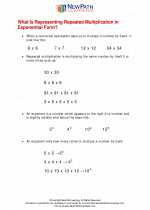Polynomials
A polynomial is a mathematical expression consisting of variables, coefficients, and exponents that are combined using addition, subtraction, and multiplication, but not division by a variable. The general form of a polynomial is:
P(x) = anxn + an-1xn-1 + ... + a1x + a0
Where:
- P(x) is the polynomial function
- an, an-1, ..., a1, a0 are the coefficients
- x is the variable
- n is a non-negative integer and represents the degree of the polynomial
Polynomials can have one or more terms, and the degree of the polynomial is determined by the term with the highest exponent.
Types of Polynomials
There are different types of polynomials based on their degree:
- Constant Polynomial: A polynomial of degree 0, such as P(x) = 5, where the value of the polynomial is a constant.
- Linear Polynomial: A polynomial of degree 1, such as P(x) = 3x + 4.
- Quadratic Polynomial: A polynomial of degree 2, such as P(x) = 2x2 - 3x + 1.
- Cubic Polynomial: A polynomial of degree 3, such as P(x) = 4x3 - 2x2 + x - 5.
- Quartic Polynomial: A polynomial of degree 4, such as P(x) = x4 + 2x3 - 3x2 + 4x - 1.
- And so on...
Operations with Polynomials
There are four main operations that can be performed with polynomials:
- Addition: To add polynomials, simply combine like terms. For example, (3x2 + 2x + 5) + (2x2 - 3x + 1) = 5x2 - x + 6.
- Subtraction: To subtract polynomials, distribute the negative sign and then add like terms. For example, (3x2 + 2x + 5) - (2x2 - 3x + 1) = x2 + 5x + 4.
- Multiplication: To multiply polynomials, use the distributive property and then combine like terms. For example, (3x + 2)(2x - 1) = 6x2 - x + 4.
- Division: Division of polynomials involves long division or synthetic division, which is beyond the scope of this overview.
Factoring Polynomials
Factoring involves expressing a polynomial as the product of other polynomials. Common factoring techniques include:
- Greatest Common Factor (GCF) Factoring: Find the greatest common factor of all the terms and factor it out. For example, factoring 6x3 - 3x2 + 9x results in 3x(2x2 - x + 3).
- Factoring by Grouping: Group the terms of the polynomial and then factor out the common factors. For example, factoring 2x3 + 3x2 - 2x - 3 involves grouping and factoring to get (2x2 + 3)(x - 1).
- Special Factoring Patterns: Recognize special patterns such as the difference of squares, perfect square trinomials, and sum/difference of cubes to factorize the polynomial.
Study Guide
Here are some key points to remember when studying polynomials:
- Identify the degree and leading coefficient of a polynomial.
- Understand the terms, coefficients, and exponents within a polynomial.
- Practice adding, subtracting, and multiplying polynomials.
- Learn and apply factoring techniques to factorize polynomials.
- Recognize and apply special factoring patterns when factoring polynomials.
By mastering these concepts and techniques, you will develop a strong understanding of polynomials and their applications in mathematics.
.◂Math Worksheets and Study Guides Sixth Grade. Repeated Multiplication to Exponents

 Worksheet/Answer key
Worksheet/Answer key
 Worksheet/Answer key
Worksheet/Answer key
 Worksheet/Answer key
Worksheet/Answer key
